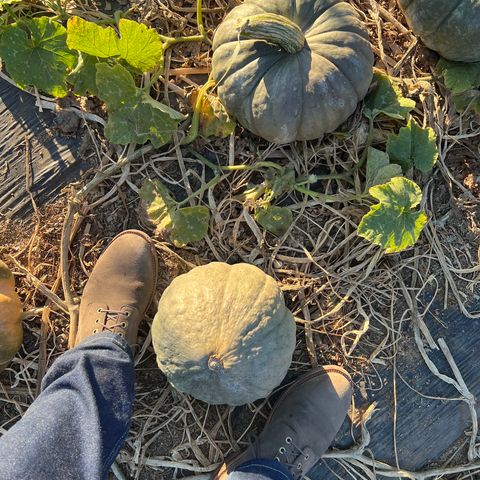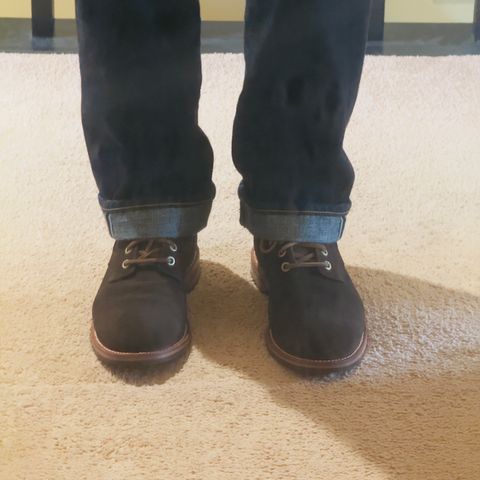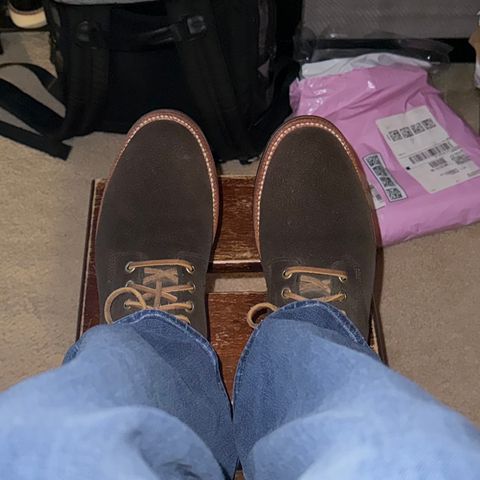About
Loden is a dark seaweed green color variation of Janus Calf Suede, a premium calf suede leather produced by Charles F. Stead in Leeds, United Kingdom. The leather features a luxuriously silky suede side with a natural full grain aniline reverse, made from selected young calf skins. Loden Janus Calf Suede is chrome tanned and dyed completely for a strong and deep color, with the distinctive loden green shade appearing greenish in natural light while showing brown tones in darker lighting.
About
Loden is a dark seaweed green color variation of Janus Calf Suede, a premium calf suede leather produced by Charles F. Stead in Leeds, United Kingdom. The leather features a luxuriously silky suede side with a natural full grain aniline reverse, made from selected young calf skins. Loden Janus Calf Suede is chrome tanned and dyed completely for a strong and deep color, with the distinctive loden green shade appearing greenish in natural light while showing brown tones in darker lighting.
The name "loden" derives from traditional Alpine textile heritage, referencing the earthy green color historically associated with loden wool fabric from the Austrian region of Tyrol. This rich, dark green has been a signature color in European outdoor and heritage wear since the Middle Ages, gaining particular prestige when Habsburg aristocracy adopted loden garments. The color has remained popular in heritage footwear applications, where the deep green shade provides a distinctive alternative to traditional brown and black leather options.
Color and appearance
The loden colorway presents as a dark seaweed green shade with a super fine nap characteristic of Janus Calf Suede. The color appears distinctly greenish in natural light conditions but exhibits brown undertones when viewed in darker lighting environments. This shifting appearance results from the chrome tanning process, which dyes the leather completely to achieve a strong and deep coloration throughout the hide.
The traditional loden color palette includes grey, green, and brown shades, with earthy green being the most common historical variant. The most popular modern loden shades are brown and a rich, dark green, with the green tone echoing the natural color of mountain sheep wool fibers used in traditional loden fabric production. The green loden color gained international recognition through the popularity of the Hubertus coat, a traditional Austrian hunting garment that made green the most widely recognized loden shade globally.
Heritage and etymology
The term "loden" originates from Middle High German "lode" or Old High German "lodo," meaning "coarse cloth." The color name references textile traditions from the Alpine region of Tyrol, Austria, where loden fabric was worn exclusively by the peasantry for centuries. The fabric and its associated color palette gained significant cultural elevation when Habsburg Archduke Johann adopted local Tyrolean dress, including loden garments, in the early 19th century.
The loden color's prestige increased further when Emperor Franz Josef wore hardly anything but loden throughout his reign, transforming the humble peasant fabric and its earthy green hue into a symbol of refined Austrian heritage. This historical association with Alpine tradition and aristocratic adoption has maintained the loden color's cultural significance in European heritage goods, including premium footwear leathers.
Specifications
Loden Janus Calf Suede maintains the standard technical specifications of the Janus Calf line. The leather has an average skin size of 13 to 15 square feet and a thickness of 1.4 to 1.6mm. Made from selected young calf skins, the material features a luxurious silky suede side with a natural full grain, aniline reverse. The handle is described as "a touch firmer than soft," providing structure while maintaining the characteristic suppleness expected from premium calf suede.
The full-grain construction distinguishes Janus Calf from split hide suedes, with tighter fiber structure providing enhanced water resistance and durability. This structural characteristic, combined with the finely textured nap, creates a silky, smooth appearance while maintaining shape over time. The grain side of the leather remains suitable for trim use, though the material is primarily intended as a suede with the napped side as the primary wearing surface.
Manufacturing
Charles F. Stead produces loden Janus Calf Suede at their tannery in Leeds using a tanning recipe that has remained unchanged for 50 years. The leather undergoes chrome tanning, a process that dyes the material completely to achieve the strong and deep loden green color characteristic of this variant. Originally developed for Northampton's traditional welted shoemakers, Janus Calf Suede has been considered the gold standard for footwear suede for decades.
The manufacturing process maintains the high quality standards that have made Janus Calf Suede renowned in heritage footwear applications. Each hide exhibits unique characteristics due to the natural variation in calf skins, while the consistent tanning methodology ensures reliable performance across production batches. The British tannery's establishment over a century ago and its commitment to traditional methods have sustained the reputation of Janus Calf Suede as "the finest suede available."
References
"Janus Calf". Charles F Stead and Co Ltd. Retrieved September 30, 2025.
"The Finest Calf Suede - Janus from C.F. Stead". Crown Northampton. Retrieved September 30, 2025.
"Loden Coats – Origins, Traditions and Trends in Alpine Fashion". Loden Coat. Retrieved September 30, 2025.


































































